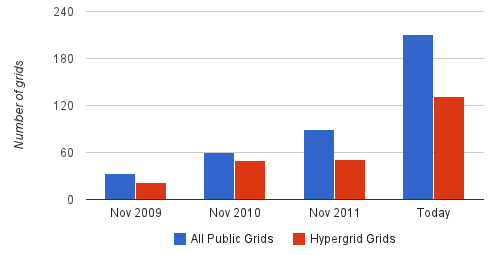On this day in 2008, Crista Lopes, a professor of informatics at the University of California, Irvine, sent an email to the OpenSim developers mailing list.

“I started working on an extension to OpenSim that makes it work in peer-to-peer mode… I’m really excited to say that this is working!” she wrote.
The email went on to detail some behind-the-scenes details of how the hypergrid was implemented, and where folks could download the code and try it out.
By the spring of 2009, several major grids were hypergrid-enabled, including OSGrid.
By November of that year, of the 33 known public OpenSim grids, 22 were hypergrid-enabled.
By November of 2010, there were 60 public grids, of which about half were hypergrid enabled. I use the word “about” because some grids turn hypergrid on and off, while others allow only outbound hypergrid teleports but not inbound ones, so it can be hard to tell which ones are hypergrid-enabled and which aren’t.
By November of 2011, there were 90 public grids, of which 51 were hypergrid-enabled.
Today, there are 211 active grids, of which 132 are known to be hypergrid-enabled.

When the hypergrid was first invented four years ago, it was missing several key functions we take for granted today.
For example, users could not access their inventories after they teleported to a new grid.
Today, not only can hypergrid travelers access their inventories and even buy stuff on foreign grids, they can also make friends on other grids and send messages to them, save hypergrid landmarks, and create groups with members from many grids.
Putting a grid on the hypergrid has also never been easier, with OpenSim hosting companies like Dreamland Metaverse making it as simple as checking the “hypergrid” box on a Web control panel.
The next big evolution of the hypergrid is expected next year, with Hypergrid 2.5, when content-level permissions will make it safer for commercial grids to enable hypergrid connectivity while maintaining the same level of intellectual property protection they have now with hypergrid turned off.
- OSgrid back online after extended maintenance - April 16, 2025
- Analysts predict drop in headset sales this year - March 25, 2025
- OSgrid enters immediate long-term maintenance - March 5, 2025
